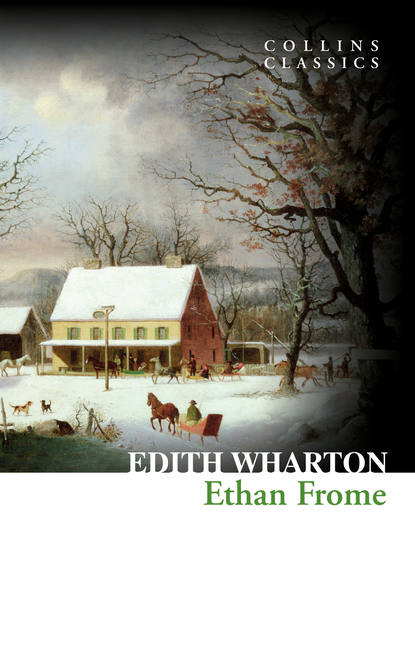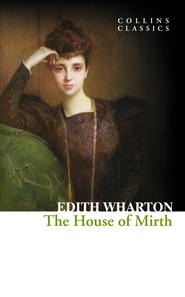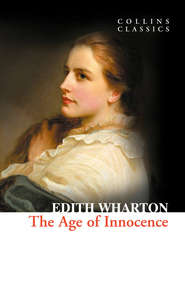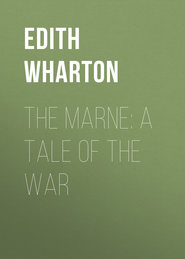По всем вопросам обращайтесь на: info@litportal.ru
(©) 2003-2024.
✖
Ethan Frome
Настройки чтения
Размер шрифта
Высота строк
Поля
Ethan Frome
Edith Wharton
HarperCollins is proud to present its incredible range of best-loved, essential classics.‘He looked at her hair and longed to touch it again, and to tell her that it smelt of the woods; but he had never learned to say such things…’One harsh winter in 1900s New England, Ethan Frome toils at his farm while struggling to maintain a bearable existence with his forbidding wife, Zeena. When Ethan takes Zeena’s cousin, Mattie, home from a dance he is entranced: Mattie brings with her the possibility for happiness, and with that she quickly becomes a symbol of hope for Ethan.First published in 1911, Ethan Frome is an intimate look at choices not made and lives not yet lived. Told through the eyes of a city outsider, this heartbreaking portrait of three lives haunted by thwarted dreams remains for many the most subtle and moving of Wharton’s works.
ETHAN FROME
Edith Wharton
Copyright (#u736e2157-7449-540b-910b-741ca78651fe)
William Collins
An imprint of HarperCollinsPublishers
1 London Bridge Street
London SE1 9GF
WilliamCollinsBooks.com (http://www.WilliamCollinsBooks.com)
This eBook published by William Collins in 2015
Life & Times section © HarperCollinsPublishers Ltd
Gerard Cheshire asserts his moral right as author of the Life & Times section
Classic Literature: Words and Phrases adapted from
Collins English Dictionary
Cover by e-Digital Design. Cover image: Seven Miles to Farmington c. 1853 (oil on canvas), George Henry Durrie (1820–63)/Florence Griswold Museum, Old Lyme, Connecticut, USA/Gift of the Hartford Steam Boiler Inspection & Insurance Co./Bridgeman images
A catalogue record for this book is available from the British Library.
All rights reserved under International and Pan-American Copyright Conventions. By payment of the required fees, you have been granted the non-exclusive, non-transferable right to access and read the text of this e-book on-screen. No part of this text may be reproduced, transmitted, down-loaded, decompiled, reverse engineered, or stored in or introduced into any information storage and retrieval system, in any form or by any means, whether electronic or mechanical, now known or hereinafter invented, without the express written permission of HarperCollins.
Source ISBN: 9780008110543
Ebook Edition © January 2015 ISBN: 9780008110550
Version: 2014-12-18
History of Collins (#u736e2157-7449-540b-910b-741ca78651fe)
In 1819, millworker William Collins from Glasgow, Scotland, set up a company for printing and publishing pamphlets, sermons, hymn books, and prayer books. That company was Collins and was to mark the birth of HarperCollins Publishers as we know it today. The long tradition of Collins dictionary publishing can be traced back to the first dictionary William published in 1824, Greek and English Lexicon. Indeed, from 1840 onwards, he began to produce illustrated dictionaries and even obtained a licence to print and publish the Bible.
Soon after, William published the first Collins novel, Ready Reckoner; however, it was the time of the Long Depression, where harvests were poor, prices were high, potato crops had failed, and violence was erupting in Europe. As a result, many factories across the country were forced to close down and William chose to retire in 1846, partly due to the hardships he was facing.
Aged 30, William’s son, William II, took over the business. A keen humanitarian with a warm heart and a generous spirit, William II was truly “Victorian” in his outlook. He introduced new, up-to-date steam presses and published affordable editions of Shakespeare’s works and ThePilgrim’s Progress, making them available to the masses for the first time. A new demand for educational books meant that success came with the publication of travel books, scientific books, encyclopedias, and dictionaries. This demand to be educated led to the later publication of atlases, and Collins also held the monopoly on scripture writing at the time.
In the 1860s Collins began to expand and diversify and the idea of “books for the millions” was developed. Affordable editions of classical literature were published, and in 1903 Collins introduced 10 titles in their Collins Handy Illustrated Pocket Novels. These proved so popular that a few years later this had increased to an output of 50 volumes, selling nearly half a million in their year of publication. In the same year, The Everyman’s Library was also instituted, with the idea of publishing an affordable library of the most important classical works, biographies, religious and philosophical treatments, plays, poems, travel, and adventure. This series eclipsed all competition at the time, and the introduction of paperback books in the 1950s helped to open that market and marked a high point in the industry.
HarperCollins is and has always been a champion of the classics, and the current Collins Classics series follows in this tradition – publishing classical literature that is affordable and available to all. Beautifully packaged, highly collectible, and intended to be reread and enjoyed at every opportunity.
Life & Times (#u736e2157-7449-540b-910b-741ca78651fe)
Wharton and Class
Many novelists use their prose as a means of expressing their frustrations with the contradictions and hypocrisies of human behaviour, often because they themselves do not adhere particularly stringently to the rules of etiquette that exist in their society. Of course 19th century societies in Britain and the USA were prone to formalizing polite society as a way of distinguishing the haves from the have-nots. Edith Wharton was born into a privileged American family, but she was equipped with the sensibilities to notice the contrasting absurdity with which many of her class went about their lives in public and in private. Like many other novelists before her, Wharton saw that people were people wherever they happened to fit in the hierarchy of society. They were equally capable of honourable and dishonourable behaviour; it is just that the upper class tended to cover up the latter and exaggerate the former for the sake of keeping up appearances. Wharton was not vitriolic though, for her writing is imbued with humour even though it criticises between the lines. The Age of Innocence is essentially a story about vanity, pride, judgement, temptation and prejudice in the well-to-do cohort of late 19th century US society. Underpinning the tale is the double-standard.
The Age of Innocence
The Age of Innocence is fundamentally about a gentleman who is engaged to be married, but allows his affections to stray toward another woman who is separated from her husband and about to divorce. In today’s occidental society the plot would barely raise an eyebrow, but in its period it would have been viewed as an absolute scandal. Wharton published the book in 1920, some 40-odd years after the time in which the story is set, but she was 58 years old and very familiar with the subject matter as she had been born and raised in the environment she describes. Even in the first quarter of the 20th century divorce was considered something of a taboo, so the book caused quite a stir. Wharton had, herself, been in a loveless marriage for almost three decades and had experienced a nervous breakdown following her divorce in 1913, so writing The Age of Innocence must have been therapeutic as well as a vessel through which Wharton could show the world her views. The basic premise of her story was that if you belong to a society that will trap you in marriage, you better be very sure that you are marrying the right person.
In society today, the finger of judgement is no longer pointed at those who do not succeed in marriage. As a consequence, many contemporary readers have an interest in Wharton’s genre. While they see that an overly formalized society can make marriage oppressive and generate double-standards, they also see that a lack of formality leads to a society where marriage is entirely devalued.
Wharton’s masterpiece is about as personal as one can get as a writer. The central character, Newland, still goes ahead with his marriage despite his obsessive feelings for the other woman, Countess Ellen. His wife, May, is consequently destined for a life of betrothal with unrequited love. So too is he of course, such is his sense of honour in being seen to do the right thing in the eyes of the society he belongs to. Following the marriage Newland cannot desist from courting Ellen and is on the verge of leaving his wife when he discovers that May is pregnant.
Ellen emigrates to Europe and Newland remains in America to feign happiness with May for the sake of their unborn child. A full quarter of a century later, Newland travels to Europe with his son, following May’s death. He has an opportunity to meet Ellen again, but realizes that he can never restore the past, so he walks away.
From Wharton’s point of view, all three characters are tragic in their own way. May lives through a marriage without real passion; Newland is tormented and then disappointed; Ellen is exiled by her family and never reunited with Newland even though the opportunity arises. It isn’t clear where Wharton places herself necessarily. Perhaps there is something of her in all three personalities, perhaps not, but the overall theme certainly echoes her own situation. Critics were so impressed by the book that Wharton was awarded the Pulitzer Prize in 1921.
The title of the novel is supposed to be satirical, a comment from Wharton on the way polite society wished to be viewed. Wharton had, in 1905, published a forerunner to The Age of Innocence in the form of The House of Mirth. The earlier book, as its title suggests, had been far more vitriolic and mocking in its condemnations and Wharton had apparently wished to redress and make amends with the later book. By the time The Age of Innocence was published the world had witnessed the Great War (World War I) and people’s attitudes had altered. Equality and egalitarianism were taking over from elitism and etiquette. In addition, in 1919 congress bowed to the pressures of suffrage and gave US women the vote. All in all, the USA had changed markedly in the 15 years between Wharton’s two novels and it was now ready to recognize and celebrate the importance of her work.
In some respects Wharton’s theme belongs to the same stable as those addressed by Jane Austen a century earlier in England. Austen’s stories, like Wharton’s, work within a behavioural framework of etiquette which is no longer relevant. Nevertheless, the drama, romance and tragedy is consequently heightened as a result of the limiting strict societal rules.
Ethan Frome
In 1911, the year that Wharton moved to Europe after the breakdown of her marriage, her novel Ethan Frome was published. A tragic love story, it has at its centre various idiosyncrasies of human behaviour that have significant consequences for the characters in the story.
Set in New England, the eponymous Ethan Frome falls in love with his ill wife’s cousin, Mattie, whom they have employed as a carer. Yet the relationship is doomed, and tragedy ensues. The plot is intricately linked to the polite society in which they live; there are strict rules of behaviour that cannot be broken, and it is an adherence to these that informs the lovers’ actions. Ethan Frome, similarly to the work of other novelists, uses the constraints of social etiquette as a tool for manipulating both characters and plotlines.
Imposing unwritten rules of behaviour on the characters’ sense of morality allows the author to invent emotive situations to engage their readers. The turmoil of Ethan’s mind, full of infidelity, is only worth writing about in a world where such thoughts are deemed unacceptable by the society in which he lives.
Wharton lived in era that was characterized by a seismic shift in societal norms and attitudes, in part due to the turn of the century and the advent of world conflict that it brought. The new world that emerged began slowly to feel more egalitarian, so socially divisive and restrictive rules of etiquette were increasingly disregarded.
CONTENTS
Cover (#uec10bee0-1c4c-5c44-a50a-eac0d616ed5e)
Title Page (#u8d08eadd-465a-583b-840a-811f252e4a77)
Copyright
History of Collins
Life & Times
Author’s Note
Edith Wharton
HarperCollins is proud to present its incredible range of best-loved, essential classics.‘He looked at her hair and longed to touch it again, and to tell her that it smelt of the woods; but he had never learned to say such things…’One harsh winter in 1900s New England, Ethan Frome toils at his farm while struggling to maintain a bearable existence with his forbidding wife, Zeena. When Ethan takes Zeena’s cousin, Mattie, home from a dance he is entranced: Mattie brings with her the possibility for happiness, and with that she quickly becomes a symbol of hope for Ethan.First published in 1911, Ethan Frome is an intimate look at choices not made and lives not yet lived. Told through the eyes of a city outsider, this heartbreaking portrait of three lives haunted by thwarted dreams remains for many the most subtle and moving of Wharton’s works.
ETHAN FROME
Edith Wharton
Copyright (#u736e2157-7449-540b-910b-741ca78651fe)
William Collins
An imprint of HarperCollinsPublishers
1 London Bridge Street
London SE1 9GF
WilliamCollinsBooks.com (http://www.WilliamCollinsBooks.com)
This eBook published by William Collins in 2015
Life & Times section © HarperCollinsPublishers Ltd
Gerard Cheshire asserts his moral right as author of the Life & Times section
Classic Literature: Words and Phrases adapted from
Collins English Dictionary
Cover by e-Digital Design. Cover image: Seven Miles to Farmington c. 1853 (oil on canvas), George Henry Durrie (1820–63)/Florence Griswold Museum, Old Lyme, Connecticut, USA/Gift of the Hartford Steam Boiler Inspection & Insurance Co./Bridgeman images
A catalogue record for this book is available from the British Library.
All rights reserved under International and Pan-American Copyright Conventions. By payment of the required fees, you have been granted the non-exclusive, non-transferable right to access and read the text of this e-book on-screen. No part of this text may be reproduced, transmitted, down-loaded, decompiled, reverse engineered, or stored in or introduced into any information storage and retrieval system, in any form or by any means, whether electronic or mechanical, now known or hereinafter invented, without the express written permission of HarperCollins.
Source ISBN: 9780008110543
Ebook Edition © January 2015 ISBN: 9780008110550
Version: 2014-12-18
History of Collins (#u736e2157-7449-540b-910b-741ca78651fe)
In 1819, millworker William Collins from Glasgow, Scotland, set up a company for printing and publishing pamphlets, sermons, hymn books, and prayer books. That company was Collins and was to mark the birth of HarperCollins Publishers as we know it today. The long tradition of Collins dictionary publishing can be traced back to the first dictionary William published in 1824, Greek and English Lexicon. Indeed, from 1840 onwards, he began to produce illustrated dictionaries and even obtained a licence to print and publish the Bible.
Soon after, William published the first Collins novel, Ready Reckoner; however, it was the time of the Long Depression, where harvests were poor, prices were high, potato crops had failed, and violence was erupting in Europe. As a result, many factories across the country were forced to close down and William chose to retire in 1846, partly due to the hardships he was facing.
Aged 30, William’s son, William II, took over the business. A keen humanitarian with a warm heart and a generous spirit, William II was truly “Victorian” in his outlook. He introduced new, up-to-date steam presses and published affordable editions of Shakespeare’s works and ThePilgrim’s Progress, making them available to the masses for the first time. A new demand for educational books meant that success came with the publication of travel books, scientific books, encyclopedias, and dictionaries. This demand to be educated led to the later publication of atlases, and Collins also held the monopoly on scripture writing at the time.
In the 1860s Collins began to expand and diversify and the idea of “books for the millions” was developed. Affordable editions of classical literature were published, and in 1903 Collins introduced 10 titles in their Collins Handy Illustrated Pocket Novels. These proved so popular that a few years later this had increased to an output of 50 volumes, selling nearly half a million in their year of publication. In the same year, The Everyman’s Library was also instituted, with the idea of publishing an affordable library of the most important classical works, biographies, religious and philosophical treatments, plays, poems, travel, and adventure. This series eclipsed all competition at the time, and the introduction of paperback books in the 1950s helped to open that market and marked a high point in the industry.
HarperCollins is and has always been a champion of the classics, and the current Collins Classics series follows in this tradition – publishing classical literature that is affordable and available to all. Beautifully packaged, highly collectible, and intended to be reread and enjoyed at every opportunity.
Life & Times (#u736e2157-7449-540b-910b-741ca78651fe)
Wharton and Class
Many novelists use their prose as a means of expressing their frustrations with the contradictions and hypocrisies of human behaviour, often because they themselves do not adhere particularly stringently to the rules of etiquette that exist in their society. Of course 19th century societies in Britain and the USA were prone to formalizing polite society as a way of distinguishing the haves from the have-nots. Edith Wharton was born into a privileged American family, but she was equipped with the sensibilities to notice the contrasting absurdity with which many of her class went about their lives in public and in private. Like many other novelists before her, Wharton saw that people were people wherever they happened to fit in the hierarchy of society. They were equally capable of honourable and dishonourable behaviour; it is just that the upper class tended to cover up the latter and exaggerate the former for the sake of keeping up appearances. Wharton was not vitriolic though, for her writing is imbued with humour even though it criticises between the lines. The Age of Innocence is essentially a story about vanity, pride, judgement, temptation and prejudice in the well-to-do cohort of late 19th century US society. Underpinning the tale is the double-standard.
The Age of Innocence
The Age of Innocence is fundamentally about a gentleman who is engaged to be married, but allows his affections to stray toward another woman who is separated from her husband and about to divorce. In today’s occidental society the plot would barely raise an eyebrow, but in its period it would have been viewed as an absolute scandal. Wharton published the book in 1920, some 40-odd years after the time in which the story is set, but she was 58 years old and very familiar with the subject matter as she had been born and raised in the environment she describes. Even in the first quarter of the 20th century divorce was considered something of a taboo, so the book caused quite a stir. Wharton had, herself, been in a loveless marriage for almost three decades and had experienced a nervous breakdown following her divorce in 1913, so writing The Age of Innocence must have been therapeutic as well as a vessel through which Wharton could show the world her views. The basic premise of her story was that if you belong to a society that will trap you in marriage, you better be very sure that you are marrying the right person.
In society today, the finger of judgement is no longer pointed at those who do not succeed in marriage. As a consequence, many contemporary readers have an interest in Wharton’s genre. While they see that an overly formalized society can make marriage oppressive and generate double-standards, they also see that a lack of formality leads to a society where marriage is entirely devalued.
Wharton’s masterpiece is about as personal as one can get as a writer. The central character, Newland, still goes ahead with his marriage despite his obsessive feelings for the other woman, Countess Ellen. His wife, May, is consequently destined for a life of betrothal with unrequited love. So too is he of course, such is his sense of honour in being seen to do the right thing in the eyes of the society he belongs to. Following the marriage Newland cannot desist from courting Ellen and is on the verge of leaving his wife when he discovers that May is pregnant.
Ellen emigrates to Europe and Newland remains in America to feign happiness with May for the sake of their unborn child. A full quarter of a century later, Newland travels to Europe with his son, following May’s death. He has an opportunity to meet Ellen again, but realizes that he can never restore the past, so he walks away.
From Wharton’s point of view, all three characters are tragic in their own way. May lives through a marriage without real passion; Newland is tormented and then disappointed; Ellen is exiled by her family and never reunited with Newland even though the opportunity arises. It isn’t clear where Wharton places herself necessarily. Perhaps there is something of her in all three personalities, perhaps not, but the overall theme certainly echoes her own situation. Critics were so impressed by the book that Wharton was awarded the Pulitzer Prize in 1921.
The title of the novel is supposed to be satirical, a comment from Wharton on the way polite society wished to be viewed. Wharton had, in 1905, published a forerunner to The Age of Innocence in the form of The House of Mirth. The earlier book, as its title suggests, had been far more vitriolic and mocking in its condemnations and Wharton had apparently wished to redress and make amends with the later book. By the time The Age of Innocence was published the world had witnessed the Great War (World War I) and people’s attitudes had altered. Equality and egalitarianism were taking over from elitism and etiquette. In addition, in 1919 congress bowed to the pressures of suffrage and gave US women the vote. All in all, the USA had changed markedly in the 15 years between Wharton’s two novels and it was now ready to recognize and celebrate the importance of her work.
In some respects Wharton’s theme belongs to the same stable as those addressed by Jane Austen a century earlier in England. Austen’s stories, like Wharton’s, work within a behavioural framework of etiquette which is no longer relevant. Nevertheless, the drama, romance and tragedy is consequently heightened as a result of the limiting strict societal rules.
Ethan Frome
In 1911, the year that Wharton moved to Europe after the breakdown of her marriage, her novel Ethan Frome was published. A tragic love story, it has at its centre various idiosyncrasies of human behaviour that have significant consequences for the characters in the story.
Set in New England, the eponymous Ethan Frome falls in love with his ill wife’s cousin, Mattie, whom they have employed as a carer. Yet the relationship is doomed, and tragedy ensues. The plot is intricately linked to the polite society in which they live; there are strict rules of behaviour that cannot be broken, and it is an adherence to these that informs the lovers’ actions. Ethan Frome, similarly to the work of other novelists, uses the constraints of social etiquette as a tool for manipulating both characters and plotlines.
Imposing unwritten rules of behaviour on the characters’ sense of morality allows the author to invent emotive situations to engage their readers. The turmoil of Ethan’s mind, full of infidelity, is only worth writing about in a world where such thoughts are deemed unacceptable by the society in which he lives.
Wharton lived in era that was characterized by a seismic shift in societal norms and attitudes, in part due to the turn of the century and the advent of world conflict that it brought. The new world that emerged began slowly to feel more egalitarian, so socially divisive and restrictive rules of etiquette were increasingly disregarded.
CONTENTS
Cover (#uec10bee0-1c4c-5c44-a50a-eac0d616ed5e)
Title Page (#u8d08eadd-465a-583b-840a-811f252e4a77)
Copyright
History of Collins
Life & Times
Author’s Note










